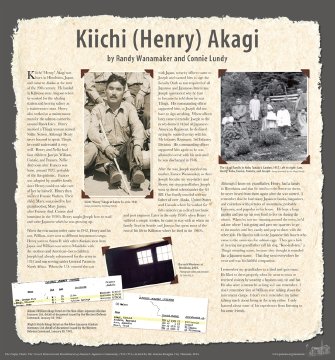|
Description
|
| Kiichi (Henry) Akagi Family by Randy Wanamaker and Connie Lundy Kiichi "Henry" Akagi was born in Hiroshima, Japan, and came to Alaska at the turn of the 20th century. He landed in Killisnoo near Angoon where he worked for the whaling station and herring saltery as a maintenance man. Henry also worked as a maintenance man for the salmon canneries around Hawk Inlet. Henry married a Tlingit woman named Nellie Nelson. Although Henry never learned to speak Tlingit, he could understand it very well. Henry and Nellie had four children: Joseph, William, Connie, and Frances. Nellie died soon after Frances was born, around 1923, probably of the flu epidemic. Frances was adopted by another family since Henry could not take care of her by himself. Henry then married Frannie Walters. Their child, Mary, was raised by her grandmother, Mary James, after Frannie died. Connie died sometime in the 1930's. Henry taught Joseph how to read and write Japanese when he was growing up. When the evacuation order came in 1942, Henry and his son, William, were sent to different internment camps. Henry went to Santa Fe with other Alaskan men from Japan and William was sent to Minidoka with the mothers and American- born children. Joseph had already volunteered for the army in 1937 and was serving under General Patton in North Africa. When the U.S. entered the war with Japan, security officers came to Joseph and wanted him to sign the Loyalty Oath as was required of all Japanese and Japanese-Americans. Joseph questioned why he had to because he told them he was Tlingit. His commanding officer supported him, so Joseph did not have to sign anything. When officers later came to transfer Joseph to the newly-formed 442nd all Japanese-American Regiment, he declined saying he wanted to stay with his 7th Infantry Regiment, 3rd Infantry Division. His commanding officer supported him again so he was allowed to serve with his unit until he was discharged in 1946. After the war, Joseph married my mother, Eunice Wanamaker, so then Joseph became my step-father and Henry, my step grandfather. Joseph went to diesel school under the GI Bill. Our family traveled with my father all over Alaska, United States and Canada where he worked for fish canneries as a diesel mechanic and port engineer. Later in the early 1950's when Henry suffered a couple strokes, he came to stay with us when my family lived in Seattle and Juneau, but spent most of the rest of his life in Killisnoo where he died in the 1960's. Although I know my grandfather, Henry, had a family in Hiroshima and that he used to write letters to them, he never heard from them again after the war started. I remember that he had many Japanese books, magazines and calendars with pictures of mountains, probably Fujiyama, and pagodas in his house. He kept a large garden and put up his own food to live on during the winter. When he saw me running around the town, he'd ask me where I was going and gave me quarters to go to the movies and buy candy and pop to share with the other kids. He liked to talk to the Japanese fish buyers who came to the canneries for salmon eggs. They got a kick of hearing my grandfather call his dog, "Koo-kuh-ten," a Tlingit sounding name, because they thought it sounded like a Japanese name. That dog went everywhere he went and was his faithful companion. I remember my grandfather as a kind and quiet man. He liked to dress properly when he went to town or received visitors by wearing a business suit, tie and hat. He also wore a mustache as long as I can remember. I don't remember him or William ever talking about the internment camps. I don't even remember my father talking much about being in the army either. I only learned about some of his experiences from listening to his army friends. Image Captions: The Akagi Family in Nobu Tanaka's Garden, 1957. Left to right: Sam, Henry, Nobu, Eunice, Pamela, and Joseph. Image courtesy of the Akagi family. Kiichi "Henry" Akagi at Camp Santa Fe, circa 1941. Image courtesy of the Akagi family Kiichi "Henry" Akagi listed on the Alien Japanese Alaskan Internees List, detail of document issued by the Western Defense Command, January 30, 1943. William Akagi listed on the Non-Alien Japanese Alaskan Evacuees List, detail of document issued by the Western Defense Command, 1942. Barrack Windows at Minidoka, 2003, photograph taken by and courtesy of Sam Kito. |
Kiichi (Henry) Akagi Panel
-The Empty Chair: The Forced Removal and Relocation of Juneau's Japanese, 1941-1951
-Permission to use this image may be obtained by contacting museum staff.

All images are the property of the Juneau-Douglas City Museum. No image may be copied, downloaded or reproduced without the express permission of the Juneau-Douglas City Museum.

All images are the property of the Juneau-Douglas City Museum. No image may be copied, downloaded or reproduced without the express permission of the Juneau-Douglas City Museum.